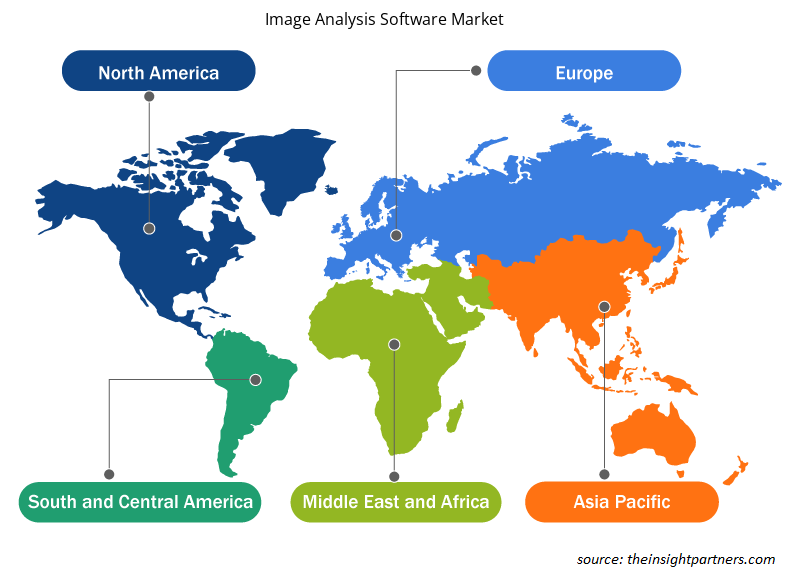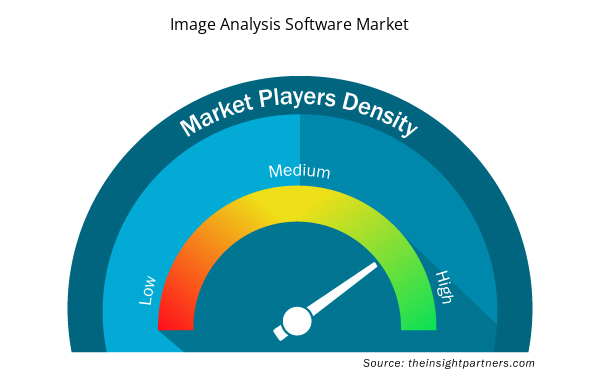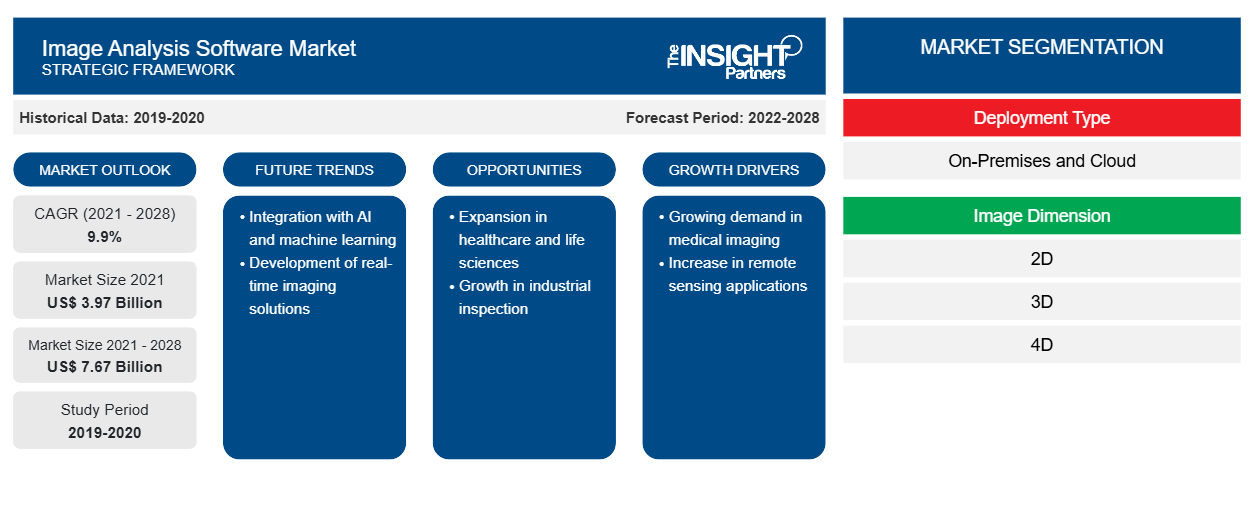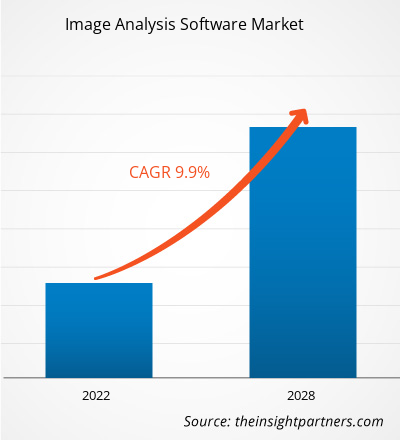[تقرير بحثي] من المتوقع أن ينمو سوق برامج تحليل الصور من 3،970.93 مليون دولار أمريكي في عام 2021 إلى 7،672.16 مليون دولار أمريكي بحلول عام 2028؛ ومن المتوقع أن ينمو بمعدل نمو سنوي مركب قدره 9.9٪ من عام 2021 إلى عام 2028.
يساعد سوق برامج تحليل الصور ، المعروف غالبًا باسم سوق تحليل الصور، في استخراج البيانات القيمة من الصور، ومعظمها صور رقمية، باستخدام تقنيات معالجة الصور الرقمية. يمكن أن تتراوح مهام تحليل الصور من بسيطة مثل مسح العلامات الشريطية إلى معقدة مثل التعرف على وجه الشخص. مطلوب من أجهزة الكمبيوتر معالجة كميات هائلة من البيانات، والوظائف التي تتطلب حوسبة معقدة، واستخراج البيانات الكمية. عندما يقوم الكمبيوتر أو المعدات الكهربائية بتحليل صورة لاستخراج معلومات قابلة للاستخدام، يُعرف ذلك باسم تحليل الصور الرقمية أو تحليل الصور بالكمبيوتر. إنه يدمج التعرف على الأنماط والهندسة الرقمية ومعالجة الإشارات في مجالات الرؤية الحاسوبية أو الآلية والتصوير الطبي .
تعمل تطبيقات برامج تحليل الصور التي تعمل بالذكاء الاصطناعي (AI) والتعلم الآلي (ML) على إعادة تعريف صناعة السيارات. يتم استخدامه الآن في صناعة تصنيع السيارات في التصميم وسلسلة التوريد والإنتاج وما بعد الإنتاج. علاوة على ذلك، يتم استخدام الذكاء الاصطناعي والتعلم الآلي في أنظمة "مساعدة القيادة" و"تقييم مخاطر السائق"، مما يؤدي إلى إحداث ثورة في صناعة النقل. يغير الذكاء الاصطناعي أيضًا العديد من خدمات ما بعد البيع، مثل الصيانة التنبؤية والتأمين. في قطاع السيارات، أدى التعلم الآلي إلى تطوير منتجات ذكية جديدة وتحسين أساليب العمل.
إن العثور على الأشكال والتعرف على الحواف وتقليل الضوضاء وعد الأشياء وتوليد الإحصائيات لتحليل الملمس أو جودة الصورة كلها أمثلة على مهام تحليل الصور. إنه التوصيف الكمي أو النوعي للصور الرقمية في بعدين (2D) أو ثلاثة أبعاد (3D)، حيث تحلل الرؤية الحاسوبية الصور ثنائية الأبعاد، بينما تحلل التصوير الطبي الصور ثلاثية الأبعاد. تُستخدم برامج تحليل الصور على نطاق واسع في تحليل صور المجاهر ودراسة الصور العلمية. يرجع نمو سوق برامج تحليل الصور بشكل أساسي إلى التبني الواسع النطاق للبرامج في صناعة الرعاية الصحية وعلوم الحياة.
قم بتخصيص هذا التقرير ليناسب متطلباتك
ستحصل على تخصيص لأي تقرير - مجانًا - بما في ذلك أجزاء من هذا التقرير، أو تحليل على مستوى الدولة، وحزمة بيانات Excel، بالإضافة إلى الاستفادة من العروض والخصومات الرائعة للشركات الناشئة والجامعات
- احصل على أهم اتجاهات السوق الرئيسية لهذا التقرير.ستتضمن هذه العينة المجانية تحليلاً للبيانات، بدءًا من اتجاهات السوق وحتى التقديرات والتوقعات.
تأثير جائحة كوفيد-19 على سوق برامج تحليل الصور
استفاد سوق برامج تحليل الصور من جائحة كوفيد-19. تواجه الشركات تحديات جديدة بسبب جائحة كوفيد-19 وتطوير بيئات العمل عن بعد. سلط تفشي كوفيد-19 الضوء على ضرورة قيام الشركات في مختلف الصناعات بتبني التقنيات الرقمية والاستفادة من إمكانات حلول وخدمات سوق برامج تحليل الصور لتحسين العمليات والتكاليف، مما سيزيد من عائد الاستثمار على أدوات تكنولوجيا المعلومات. علاوة على ذلك، أدى وصول الوباء في عام 2020 إلى ظهور مجموعة من التحديات لعمليات سوق برامج تحليل الصور العالمية. انهارت البنى التحتية للرعاية الصحية في الاقتصادات المتقدمة بسبب ارتفاع حالات كوفيد-19. لذلك، تتطلب حالة الطوارئ الصحية العامة تدخل الحكومة والجهات الفاعلة في السوق والمساعدة في إحياء عمليات سوق برامج تحليل الصور والإيرادات من خلال الجهود التعاونية لمبادرات البحث والتطوير التي تم اتخاذها لاسترداد الخسائر خلال فترة التنبؤ. بالإضافة إلى ذلك، تبشر الاستثمارات المتزايدة بالخير لسوق برامج تحليل الصور في السنوات التالية.
نظرة عامة على سوق برامج تحليل الصور
الطلب المتزايد على تطبيقات ومنتجات الأمان التي تدعم تحليل الصور
بدأت الشركات تدرك الإمكانات الكامنة في استخلاص الموارد من البيانات غير المنظمة. ويمكنها استخدام الصور أو مقاطع الفيديو لخلق تجربة استهلاكية فريدة وجذابة في قطاعات البيع بالتجزئة والترفيه والمطالبات التأمينية وغيرها من الصناعات. ويُستخدم تحليل الصور لدعم عدد متزايد من حالات الاستخدام المؤسسية. وتنشأ هذه التطبيقات العملية للتعلم العميق وتحليل الصور عن التقدم في خوارزميات التعلم الآلي ، وتوافر مجموعات البيانات، ووجود تكنولوجيا قوية مع منصات تسمح بالمعالجة في الوقت الفعلي. وتعمل العديد من المطارات في الولايات المتحدة على ترقية معداتها لتمكين القياسات الحيوية مثل مسح الأصابع أو القزحية كتقنية فحص أمنية بديلة. وتتوقع الشركات زيادة السعة بشكل كبير من خلال نشر تكنولوجيا تحليل الصور لنقل الركاب من الوصول عبر الأمن إلى بوابة المغادرة الخاصة بهم.
سوق برامج تحليل الصور - نظرة عامة على شرائح نوع النشر
بناءً على النشر، ينقسم سوق برامج تحليل الصور إلى محلي وسحابي. يتم تثبيت البرامج المحلية وتشغيلها على أجهزة الكمبيوتر في مقر المستخدم أو المؤسسة بدلاً من منشأة بعيدة، مثل مزرعة الخوادم أو السحابة. نظرًا لأن البرامج المحلية توفر مرونة واستقرارًا وأمانًا أفضل، فإن العديد من اللاعبين في السوق يبيعون الآن برامج محلية. على سبيل المثال، تتوفر حلول الذكاء الاصطناعي المرئي المحلية من Imagga للنشر الكامل على خوادم محلية خاصة بالشركة. يمكن للمؤسسات الحساسة للبيانات استخدام تقنية الذكاء الاصطناعي المرئي الحائزة على جوائز من Imagga لأداء العلامات التلقائية والتصنيف التلقائي واستخراج الألوان والتدريب المخصص والتعرف على الوجه مع الحفاظ على الامتثال الكامل لقوانين وأنظمة الخصوصية.
سوق برامج تحليل الصور - نظرة عامة على شريحة أبعاد الصورة
بناءً على أبعاد الصورة، يتم تقسيم سوق برامج تحليل الصور إلى ثنائية الأبعاد وثلاثية الأبعاد ورباعية الأبعاد. يتم إنشاء الصورة ثنائية الأبعاد باستخدام المحورين x وy. تقليديًا، تم استخدام الصور ثنائية الأبعاد كمصدر للرسوم المتحركة والفيديو. إنها تقنية قديمة ذات تاريخ طويل، ومع ذلك فهي لا تزال كلاسيكية لسبب وجيه. هذه الصور بسيطة وجذابة بصريًا وسهلة الاستهلاك دون أن تكون ساحقة أو مزعجة للعملاء. الصور ثنائية الأبعاد شائعة في الرسوم المتحركة وألعاب الفيديو لأنها توفر منظورًا واقعيًا ومسطحًا للحركة على الشاشة. وبالتالي، تقدم العديد من الشركات في الصناعة الآن برامج لتحليل الصور ثنائية الأبعاد. على سبيل المثال، يساعد برنامج تحليل الصور ثنائية الأبعاد Image-Pro Plus من Media Cybernetics, Inc. في جمع الصور ببساطة، وعدها، وقياسها، وتصنيف العناصر، وأتمتة المهمة. يتم تضمين التحكم في المجهر، والتقاط الصور، والقياس، والعد/الحجم، وقدرات تطوير الماكرو في حزمة البرامج هذه.
سوق برامج تحليل الصور - نظرة عامة على القطاعات الرأسية للصناعة
بناءً على الصناعة العمودية، يتم تقسيم سوق برامج تحليل الصور إلى الرعاية الصحية وعلوم الحياة والتصنيع والأوساط الأكاديمية والمعادن والمعادن والنفط وغيرها. في الصناعة الطبية، تعد برامج تحليل الصور مفيدة في مجالات مختلفة مثل علم الأعصاب وأمراض القلب والعظام وطب الأسنان وعلم الأورام. يمكن للبرنامج قراءة الصور التي تم إنشاؤها بواسطة الأشعة السينية والتصوير بالرنين المغناطيسي والتصوير المقطعي المحوسب والتصوير المقطعي بالإصدار البوزيتروني والموجات فوق الصوتية. ونتيجة لذلك، يمكن أتمتة العمليات وتسريعها لتجنب العمل اليدوي وتوفير الوقت. قد يتعلم البرنامج التعرف على ميزات معينة في هذه الصور، مما يجعل إجراء التشخيص سريعًا ودقيقًا. تتمتع برامج معالجة الصور الطبية بالعديد من القدرات. تكتشف الحلول القائمة على الذكاء الاصطناعي المخالفات والشذوذ الخطير المحتمل وتظهر أيضًا ما إذا كان المريض يعاني من السرطان أو ورم حميد. يمكن للبرنامج قراءة الصور ثلاثية الأبعاد وما يسمى بالصور رباعية الأبعاد بالإضافة إلى الصور العادية ثنائية الأبعاد (التي تعرض التغييرات بمرور الوقت).
سوق برامج تحليل الصور
يركز لاعبو سوق برامج تحليل الصور على ابتكارات وتطويرات المنتجات الجديدة من خلال دمج التقنيات والميزات المتقدمة للتنافس. في أكتوبر 2021، تضمنت Clemex Vision تعليمات فريدة للحبيبات المارتنسيتية والفيريتية والأستينيتية، بالإضافة إلى قدرات التعلم الآلي. تمت إضافة هذه الأساليب التلقائية الجديدة إلى مجموعة أدوات البرنامج الحالية لتوفير تقنية سريعة ودقيقة لتحديد الهياكل الدقيقة الصعبة بصريًا.
بناءً على نوع النشر، ينقسم سوق برامج تحليل الصور إلى محلي وسحابي. بناءً على أبعاد الصورة، يتم تقسيم سوق برامج تحليل الصور إلى ثنائي الأبعاد وثلاثي الأبعاد ورباعي الأبعاد. حسب القطاع الرأسي للصناعة، يتم تقسيم سوق برامج تحليل الصور إلى الرعاية الصحية وعلوم الحياة والتصنيع والأوساط الأكاديمية والمعادن والنفط وغيرها. بناءً على المنطقة، يتم تقسيم سوق برامج تحليل الصور العالمية إلى أمريكا الشمالية وأوروبا ومنطقة آسيا والمحيط الهادئ والشرق الأوسط وأفريقيا وأمريكا الجنوبية.
رؤى إقليمية حول سوق برامج تحليل الصور
لقد قام المحللون في Insight Partners بشرح الاتجاهات والعوامل الإقليمية المؤثرة على سوق برامج تحليل الصور طوال فترة التوقعات بشكل شامل. يناقش هذا القسم أيضًا قطاعات سوق برامج تحليل الصور والجغرافيا في جميع أنحاء أمريكا الشمالية وأوروبا ومنطقة آسيا والمحيط الهادئ والشرق الأوسط وأفريقيا وأمريكا الجنوبية والوسطى.

- احصل على البيانات الإقليمية المحددة لسوق برامج تحليل الصور
نطاق تقرير سوق برامج تحليل الصور
| سمة التقرير | تفاصيل |
|---|---|
| حجم السوق في عام 2021 | 3.97 مليار دولار أمريكي |
| حجم السوق بحلول عام 2028 | 7.67 مليار دولار أمريكي |
| معدل النمو السنوي المركب العالمي (2021 - 2028) | 9.9% |
| البيانات التاريخية | 2019-2020 |
| فترة التنبؤ | 2022-2028 |
| القطاعات المغطاة | حسب نوع النشر
|
| المناطق والدول المغطاة | أمريكا الشمالية
|
| قادة السوق وملفات تعريف الشركات الرئيسية |
|
كثافة اللاعبين في السوق: فهم تأثيرها على ديناميكيات الأعمال
يشهد سوق برامج تحليل الصور نموًا سريعًا، مدفوعًا بالطلب المتزايد من المستخدم النهائي بسبب عوامل مثل تفضيلات المستهلك المتطورة والتقدم التكنولوجي والوعي المتزايد بفوائد المنتج. ومع ارتفاع الطلب، تعمل الشركات على توسيع عروضها والابتكار لتلبية احتياجات المستهلكين والاستفادة من الاتجاهات الناشئة، مما يؤدي إلى زيادة نمو السوق.
تشير كثافة اللاعبين في السوق إلى توزيع الشركات أو المؤسسات العاملة في سوق أو صناعة معينة. وهي تشير إلى عدد المنافسين (اللاعبين في السوق) الموجودين في مساحة سوق معينة نسبة إلى حجمها أو قيمتها السوقية الإجمالية.
الشركات الرئيسية العاملة في سوق برامج تحليل الصور هي:
- شركة أدسيس السعودية
- مختبرات بيو راد، المحدودة
- أوكسفورد إنسترومنتس
- شركة كليمكس للتكنولوجيا
- وسائل الإعلام السيبرنيتية، المحدودة
إخلاء المسؤولية : الشركات المذكورة أعلاه ليست مرتبة بأي ترتيب معين.

- احصل على نظرة عامة على أهم اللاعبين الرئيسيين في سوق برامج تحليل الصور
سوق برامج تحليل الصور – نبذة عن الشركة
- شركة أدسيس السعودية
- مختبرات بيو راد، المحدودة
- أوكسفورد إنسترومنتس
- شركة كليمكس للتكنولوجيا
- وسائل الإعلام السيبرنيتية، المحدودة
- شركة ميبار للبرمجيات
- شركة أوليمبوس
- باكس-ات
- شركة بيركين إلمر
- شركة تيوسيجنوستيكس المحدودة
- شركة لايكا مايكروسيستمز المحدودة
- شركة ام في تيك للبرمجيات
- شركة كارل زايس ايه جي
- شركة Scale AI
- شركة لاب بوكس
- شركة في 7 المحدودة
- التحليل التاريخي (سنتان)، السنة الأساسية، التوقعات (7 سنوات) مع معدل النمو السنوي المركب
- تحليل PEST و SWOT
- حجم السوق والقيمة / الحجم - عالميًا وإقليميًا وقطريًا
- الصناعة والمنافسة
- مجموعة بيانات Excel


- Terahertz Technology Market
- Adaptive Traffic Control System Market
- Machine Condition Monitoring Market
- Sweet Potato Market
- Architecture Software Market
- Wire Harness Market
- Parking Management Market
- Electronic Toll Collection System Market
- Blood Collection Devices Market
- Asset Integrity Management Market

Report Coverage
Revenue forecast, Company Analysis, Industry landscape, Growth factors, and Trends

Segment Covered
This text is related
to segments covered.

Regional Scope
North America, Europe, Asia Pacific, Middle East & Africa, South & Central America

Country Scope
This text is related
to country scope.
الأسئلة الشائعة
North America held the largest market share in year 2020, along with the notable revenue generation opportunities in Europe and APAC.
Key companies in the image analysis software market include ADCIS SA; Bio-Rad Laboratories, Inc.; Oxford Instruments; Clemex Technologies, Inc.; Media Cybernetics, Inc.; MIPAR Software LLC; Olympus Corporation; Pax-it; PerkinElmer, Inc.; TissueGnostics GmbH; Leica Microsystems GmbH; MVTec Software GmbH; Carl Zeiss AG; Scale AI, Inc.; Labelbox, Inc; and V7 Ltd.
The Image analysis software market is segmented into on-premises and cloud based on the deployment type. The global image analysis software market is dominated by on-premise segment in 2020, which accounted for more than ~ 60%.
Visual AI allows new and experienced users to effortlessly construct and deploy more accurate and explicable machine learning models with photos through community hardware. Computer vision will enable users to manipulate pictures as they would any other type of data. Enterprise AI systems automate the preparation, selection, and training of a wide range of cutting-edge deep learning models so that the optimal deployment model may be recommended. As social separation becomes the new normal, it's more important than ever to watch and monitor people's gatherings and movements. Standard Operating Procedures (SOPs) must be implemented and tracked in real-time by businesses. Employees can maintain safe, specified distances from one another throughout shifts while following conventional practices thanks to computer algorithms that evaluate data from on-site video cameras. Retailers may utilize AI and machine learning tools to keep track of the distances between their warehouse employees. When a divergence from typical behavior is detected, these tools issue real-time alerts., which in turn is likely to gain momentum for the image analysis software market over the forecasted period.
AI is becoming the next frontier in digital transformation, and when integrated into processes, it can deliver value and impact across all facets of a company. AWS, Microsoft, and Google are all aggressively investing in improving their image analysis software solutions to improve in-store and online retail performance. Due to the emergence of COVID-19, demand for cloud-based services has increased even more. Intelligence Retail, a supplier of computer vision and AI for merchandising solutions, uses IBM's cloud and analysis solution, which includes cutting-edge Graphics Processing Units (GPUs), to help businesses increase sales, lower audit costs, improve performance, and increase customer loyalty. For example, Trax and Google Cloud teamed in 2019 to use Google's cloud and edge computing technologies, as well as Trax's image recognition and machine learning capabilities, to successfully manage in-store inventory and every SKU on the shelf with actionable real-time insights. These strategies would promote the future growth of the image analysis market in the forecasted period.
Growing demand for image analysis-enabled security applications and products
Increasing demand for image analysis in the automotive industry
Trends and growth analysis reports related to Technology, Media and Telecommunications : READ MORE..
The List of Companies - Image Analysis Software Market
- ADCIS SA
- Bio-Rad Laboratories, Inc.
- Oxford Instruments
- Clemex Technologies, Inc.
- Media Cybernetics, Inc.
- MIPAR Software LLC
- Olympus Corporation
- Pax-it
- PerkinElmer, Inc.
- TissueGnostics GmbH
- Leica Microsystems GmbH
- MVTec Software GmbH
- Carl Zeiss AG
- Scale AI, Inc.
- Labelbox, Inc
- V7 Ltd
The Insight Partners performs research in 4 major stages: Data Collection & Secondary Research, Primary Research, Data Analysis and Data Triangulation & Final Review.
- Data Collection and Secondary Research:
As a market research and consulting firm operating from a decade, we have published and advised several client across the globe. First step for any study will start with an assessment of currently available data and insights from existing reports. Further, historical and current market information is collected from Investor Presentations, Annual Reports, SEC Filings, etc., and other information related to company’s performance and market positioning are gathered from Paid Databases (Factiva, Hoovers, and Reuters) and various other publications available in public domain.
Several associations trade associates, technical forums, institutes, societies and organization are accessed to gain technical as well as market related insights through their publications such as research papers, blogs and press releases related to the studies are referred to get cues about the market. Further, white papers, journals, magazines, and other news articles published in last 3 years are scrutinized and analyzed to understand the current market trends.
- Primary Research:
The primarily interview analysis comprise of data obtained from industry participants interview and answers to survey questions gathered by in-house primary team.
For primary research, interviews are conducted with industry experts/CEOs/Marketing Managers/VPs/Subject Matter Experts from both demand and supply side to get a 360-degree view of the market. The primary team conducts several interviews based on the complexity of the markets to understand the various market trends and dynamics which makes research more credible and precise.
A typical research interview fulfils the following functions:
- Provides first-hand information on the market size, market trends, growth trends, competitive landscape, and outlook
- Validates and strengthens in-house secondary research findings
- Develops the analysis team’s expertise and market understanding
Primary research involves email interactions and telephone interviews for each market, category, segment, and sub-segment across geographies. The participants who typically take part in such a process include, but are not limited to:
- Industry participants: VPs, business development managers, market intelligence managers and national sales managers
- Outside experts: Valuation experts, research analysts and key opinion leaders specializing in the electronics and semiconductor industry.
Below is the breakup of our primary respondents by company, designation, and region:

Once we receive the confirmation from primary research sources or primary respondents, we finalize the base year market estimation and forecast the data as per the macroeconomic and microeconomic factors assessed during data collection.
- Data Analysis:
Once data is validated through both secondary as well as primary respondents, we finalize the market estimations by hypothesis formulation and factor analysis at regional and country level.
- Macro-Economic Factor Analysis:
We analyse macroeconomic indicators such the gross domestic product (GDP), increase in the demand for goods and services across industries, technological advancement, regional economic growth, governmental policies, the influence of COVID-19, PEST analysis, and other aspects. This analysis aids in setting benchmarks for various nations/regions and approximating market splits. Additionally, the general trend of the aforementioned components aid in determining the market's development possibilities.
- Country Level Data:
Various factors that are especially aligned to the country are taken into account to determine the market size for a certain area and country, including the presence of vendors, such as headquarters and offices, the country's GDP, demand patterns, and industry growth. To comprehend the market dynamics for the nation, a number of growth variables, inhibitors, application areas, and current market trends are researched. The aforementioned elements aid in determining the country's overall market's growth potential.
- Company Profile:
The “Table of Contents” is formulated by listing and analyzing more than 25 - 30 companies operating in the market ecosystem across geographies. However, we profile only 10 companies as a standard practice in our syndicate reports. These 10 companies comprise leading, emerging, and regional players. Nonetheless, our analysis is not restricted to the 10 listed companies, we also analyze other companies present in the market to develop a holistic view and understand the prevailing trends. The “Company Profiles” section in the report covers key facts, business description, products & services, financial information, SWOT analysis, and key developments. The financial information presented is extracted from the annual reports and official documents of the publicly listed companies. Upon collecting the information for the sections of respective companies, we verify them via various primary sources and then compile the data in respective company profiles. The company level information helps us in deriving the base number as well as in forecasting the market size.
- Developing Base Number:
Aggregation of sales statistics (2020-2022) and macro-economic factor, and other secondary and primary research insights are utilized to arrive at base number and related market shares for 2022. The data gaps are identified in this step and relevant market data is analyzed, collected from paid primary interviews or databases. On finalizing the base year market size, forecasts are developed on the basis of macro-economic, industry and market growth factors and company level analysis.
- Data Triangulation and Final Review:
The market findings and base year market size calculations are validated from supply as well as demand side. Demand side validations are based on macro-economic factor analysis and benchmarks for respective regions and countries. In case of supply side validations, revenues of major companies are estimated (in case not available) based on industry benchmark, approximate number of employees, product portfolio, and primary interviews revenues are gathered. Further revenue from target product/service segment is assessed to avoid overshooting of market statistics. In case of heavy deviations between supply and demand side values, all thes steps are repeated to achieve synchronization.
We follow an iterative model, wherein we share our research findings with Subject Matter Experts (SME’s) and Key Opinion Leaders (KOLs) until consensus view of the market is not formulated – this model negates any drastic deviation in the opinions of experts. Only validated and universally acceptable research findings are quoted in our reports.
We have important check points that we use to validate our research findings – which we call – data triangulation, where we validate the information, we generate from secondary sources with primary interviews and then we re-validate with our internal data bases and Subject matter experts. This comprehensive model enables us to deliver high quality, reliable data in shortest possible time.


 احصل على عينة مجانية لهذا التقرير
احصل على عينة مجانية لهذا التقرير